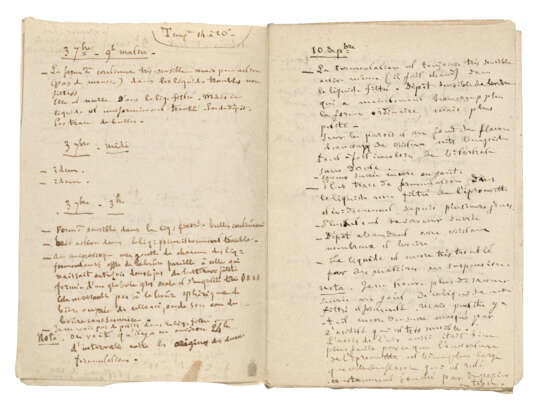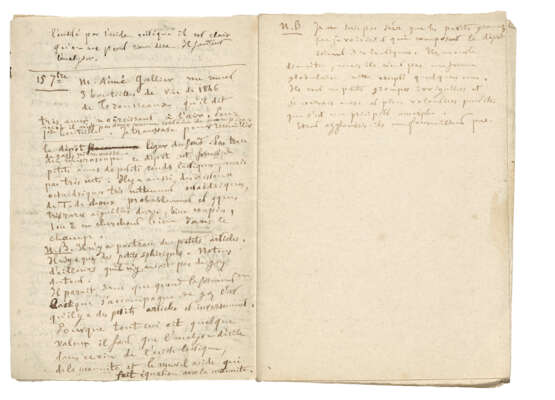ID 1109156
Lot 354 | Louis Pasteur (1822-1895)
Estimate value
£ 10 000 – 15 000
Autograph manuscript notebook, Arbois, 1-15 September 1858
In French. 10 written pages, 145 x 100mm, illustrated with small drawings. In a hand-made notebook, paper covers, tied with a cloth ribbon, annotated ‘Arbois. Vacances de 1858’ in other hands. Provenance: Christie's New York, 16 May 1984, lot 46.
Pasteur's experiments and microscopic observations on the fermentation process in wine, experiments which disproved the theory that fermentation was caused by decomposition. The present notes date from the early autumn of 1858, during a vacation from his teaching duties at the Faculté des Sciences at Lille, and were recorded at Arbois, where Pasteur’s family lived. They are illustrated with small but meticulous marginal drawing of the chemical apparatus used – such as filtration devices and flasks – and of his microscopic observations of the yeast of bacteria present in the test samples. In the first entry, dated 1 September at 5 pm, Pasteur sets out his ingredients: ‘Grapes, Garden trellis. Not very ripe...’ and the conditions of the experiment: ‘Attic. No direct sunlight on the bottles. North-west’. He extracts the juice, filters the grapes, and separates the clear liquid from the residue. In the succeeding days, he records the developing stages of fermentation in two different samples, comparing their relative temperature and aeration, appearance, odour and taste: 'The unfiltered liquid is tastier, to my mind. There is perhaps still more sugar content which masks some of the acidity, and to which it is very sensitive’. Of one set of samples he records ‘No trace of the small granules, only of the little spheres...’; in another, he decants and examines the deposit, ‘in which I can clearly distinguish a quantity of beautiful yeast particles, forming spiny rosaries’. The experiments conclude with a series performed on older wines, some Zilly of 1854 and an 1846 Trousseaux.
Pasteur had already proved, in 1857, that fermentation was a physiological process, and that yeasts were alive: his paper ‘Mémoire sur la Fermentation Appelée Lactique’ (published 30 November 1857) is considered to be the ‘first demonstration of the connection between a specific fermentation and the activity of a specific living micro-organism [..] the beginning of bacteriology as a modern science’ (Garrison-Morton) and ‘the beginning of scientific microbiology’ (Brock). His work on alcoholic fermentation was first published in 1858, as ‘Nouveaux faits concernant l'histoire de la fermentation alcoolique’ ; Pasteur’s work in the field disproved the theory propounded by Jöns Jacob Berzelius and Justus von Liebig that fermentation was caused by decomposition, demonstrating instead that yeast was responsible for fermentation to produce alcohol from sugar. He also demonstrated that, when a different microorganism contaminated the wine, lactic acid was produced, making the wine sour.
| Artist: | Louis Pasteur (1822 - 1895) |
|---|---|
| Place of origin: | France |
| Auction house category: | Medicine & science |
| Artist: | Louis Pasteur (1822 - 1895) |
|---|---|
| Place of origin: | France |
| Auction house category: | Medicine & science |
| Address of auction |
CHRISTIE'S 8 King Street, St. James's SW1Y 6QT London United Kingdom | |||||
|---|---|---|---|---|---|---|
| Preview |
| |||||
| Phone | +44 (0)20 7839 9060 | |||||
| Buyer Premium | see on Website | |||||
| Conditions of purchase | Conditions of purchase |



















